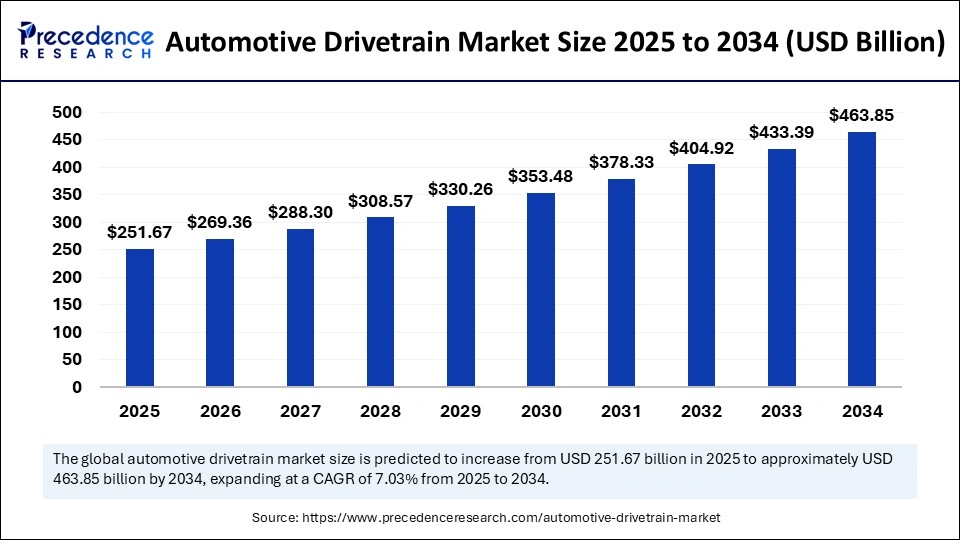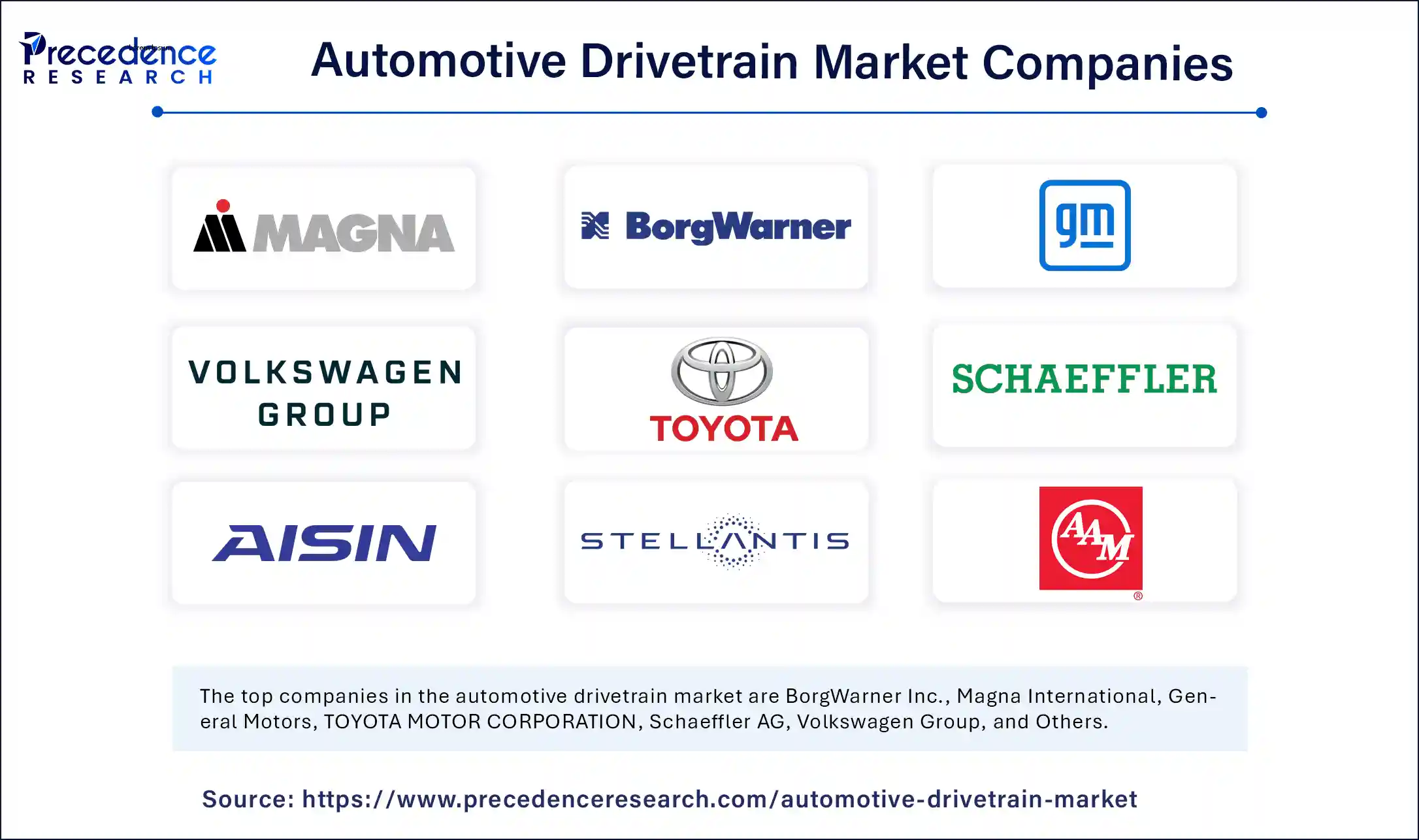
Automotive Drivetrain Market Key Highlights
-
In 2025, the global automotive drivetrain market is estimated to be worth $251.67 billion.
-
It is expected to grow and reach $463.85 billion by 2034, registering a CAGR of 7.03% during the forecast period.
-
Asia Pacific held the highest revenue share of 43% in 2024, leading the global market.
-
The European market is projected to grow steadily at a CAGR of 6.94% from 2025 to 2034.
-
By propulsion type:
-
The internal combustion engine (ICE) segment accounted for 77% of the market revenue in 2024.
-
The electric motor segment is forecasted to expand rapidly at a CAGR of 18.54% over the next decade.
-
-
By drive type:
-
The front-wheel drive (FWD) segment captured 52% of the revenue share in 2024.
-
The all-wheel drive (AWD) segment is projected to witness the highest growth rate in the coming years.
-
-
By vehicle type:
-
Passenger cars dominated the market with a 74% revenue share in 2024.
-
The commercial vehicles segment is anticipated to grow at the fastest CAGR during the forecast period.
-
Automotive Drivetrain Overview
The automotive drivetrain is a collection of components that transmit power from the vehicle’s engine to its wheels, enabling motion. It includes the transmission, driveshaft, axles, and differential. Depending on the drivetrain configuration—such as front-wheel drive (FWD), rear-wheel drive (RWD), all-wheel drive (AWD), or four-wheel drive (4WD)—the system varies in complexity and performance capability. These systems play a vital role in vehicle handling, fuel efficiency, and performance.
Current Trends and Innovations:
The drivetrain market is rapidly evolving with the rise of electric vehicles (EVs), where traditional transmission components are simplified or replaced entirely with e-drives and electric axles. There’s also a growing focus on lightweight materials and advanced software integration for better efficiency and reduced emissions. Hybrid and plug-in hybrid drivetrains are becoming more prevalent, combining internal combustion engines with electric propulsion to balance power and sustainability.
How is AI Enhancing the Efficiency and Performance of Automotive Drivetrains?
AI is playing a transformative role in optimizing drivetrain performance by enabling predictive maintenance, real-time diagnostics, and intelligent control systems. Through machine learning algorithms, AI can analyze large volumes of sensor data to predict component wear and failure before they occur, reducing downtime and maintenance costs. Additionally, AI-driven control systems can optimize torque distribution and energy usage in hybrid and electric drivetrains, leading to improved fuel efficiency and performance.
As the automotive industry moves towards electrification, AI is integral to managing complex powertrain architectures, especially in electric and hybrid vehicles. AI facilitates seamless integration of electric motors, regenerative braking systems, and battery management by ensuring optimal energy flow and performance tuning. It also enables adaptive driving strategies and personalized vehicle responses based on driver behavior, enhancing the overall driving experience and contributing to sustainability goals.
Growth Factors of the Automotive Drivetrain Market
The automotive drivetrain market is witnessing significant growth due to rapid technological advancements and the rising adoption of electric and hybrid vehicles. Automakers are increasingly focusing on enhancing powertrain efficiency, reducing emissions, and improving driving dynamics through innovations in drivetrain technologies such as AWD systems, electronically controlled differentials, and integrated electric drivetrains. Additionally, stringent environmental regulations and government incentives are accelerating the shift toward electrification, further boosting demand for advanced drivetrain systems tailored for EVs and hybrid models.
Moreover, the global increase in vehicle production—particularly in emerging markets like India, China, and Southeast Asia—is driving consistent demand for drivetrains across all vehicle segments. Growing consumer expectations for superior vehicle performance, traction, and fuel economy are pushing manufacturers to adopt more sophisticated drivetrain configurations such as 4WD and AWD systems. These factors, combined with rising disposable incomes and improved road infrastructure, are fostering a favorable environment for market expansion.
Get this report to explore global market size, share, CAGR, and trends, featuring detailed segmental analysis and an insightful competitive landscape overview@ https://www.precedenceresearch.com/sample/6193
Market Scope
| Report Coverage | Details |
| Market Size by 2034 | USD 463.85 Billion |
| Market Size in 2025 | USD 251.67 Billion |
| Market Size in 2024 | USD 235.14 Billion |
| Market Growth Rate from 2025 to 2034 | CAGR of 7.03% |
| Dominating Region | Asia Pacific |
| Fastest Growing Region | Europe |
| Base Year | 2024 |
| Forecast Period | 2025 to 2034 |
| Segments Covered | Propulsion Type, Drive Type, Vehicle Type, and Region |
| Regions Covered | North America, Europe, Asia-Pacific, Latin America, and Middle East & Africa |
Market Dynamics
Market Drivers:
The automotive drivetrain market is significantly driven by the rising global demand for vehicles, especially in emerging economies, where increasing disposable incomes and urbanization are stimulating automobile sales. The growing inclination toward fuel-efficient, high-performance, and low-emission vehicles has led to the advancement of drivetrain technologies, such as hybrid and electric drivetrains. Additionally, stringent emission regulations by governments across the globe are pushing manufacturers to develop more efficient drivetrain systems.
The integration of advanced technologies, including all-wheel drive (AWD) and four-wheel drive (4WD) systems in vehicles for improved handling and performance, further fuels market growth. The growing penetration of electric vehicles (EVs) and the corresponding development of electric drivetrains are reshaping the competitive landscape of the market, making it more innovation-centric.
Opportunities:
The shift towards electrification presents immense opportunities in the automotive drivetrain market. As OEMs transition from internal combustion engine (ICE) vehicles to electric mobility, the demand for electric and hybrid drivetrains is rising rapidly. This trend is creating avenues for the development of new drivetrain architectures, components, and software integration for improved efficiency and performance. Furthermore, government incentives, tax rebates, and subsidies promoting electric vehicle adoption are encouraging investment in EV drivetrain technologies.
The proliferation of autonomous and connected vehicles also presents an opportunity for drivetrain systems to become smarter, offering features like real-time performance monitoring, predictive maintenance, and adaptive power distribution. Emerging markets in Asia-Pacific and Latin America provide untapped potential due to growing vehicle production capabilities and favorable policy environments.
Challenges:
Despite the growth potential, the automotive drivetrain market faces several challenges. High development and manufacturing costs of advanced drivetrain systems, particularly for electric and hybrid configurations, pose a major barrier to market entry for small players. The transition from ICE to electric drivetrains involves significant infrastructure investment, including EV charging networks and battery supply chains.
Furthermore, drivetrain manufacturers must address thermal management, durability, and weight optimization issues in electric drivetrains. Supply chain disruptions, raw material shortages, and geopolitical uncertainties can also impact production and profitability. Additionally, as vehicle architectures become more complex, maintaining compatibility and standardization across multiple drivetrain types becomes increasingly difficult.
Regional Outlook:
Asia-Pacific dominates the global automotive drivetrain market, accounting for the largest revenue share, driven by strong vehicle production hubs in China, India, Japan, and South Korea. The region benefits from cost-effective manufacturing, a large consumer base, and increasing adoption of EVs, particularly in China, which is aggressively promoting electric mobility. Europe follows closely, driven by a robust automotive industry and stringent environmental regulations that accelerate the adoption of electric and hybrid vehicles.
Countries like Germany, France, and the UK are leading the way in drivetrain innovation. North America, led by the U.S., is also a key market, supported by technological advancements, growing EV infrastructure, and consumer preference for performance vehicles with AWD and 4WD systems. Meanwhile, Latin America and the Middle East & Africa are emerging markets, with growth driven by infrastructure development, economic expansion, and gradual shifts in automotive preferences.
Automotive Drivetrain Market Companies

- BorgWarner Inc.
- Magna International
- General Motors
- TOYOTA MOTOR CORPORATION
- Schaeffler AG
- Volkswagen Group
- Stellantis NV
- American Axle & Manufacturing, Inc.
- Aisin Seki Co., Ltd.
- ZF Friedrichshafen AG
- Hyundai Motor Company
Segment Covered in the Report
By Propulsion Type
- ICE
- Electric Motor
By Drive Type
- FWD
- RWD
- AWD
By Vehicle Type
- Passenger Cars
- Commercial Vehicles
By Region
- North America
- Europe
- Asia-Pacific
- Latin America
- Middle East & Africa
Also Read: In-cabin Sensing Market
Source: https://www.precedenceresearch.com/automotive-drivetrain-market
You can place an order or ask any questions, please feel free to contact at sales@precedenceresearch.com|+1 804 441 9344
